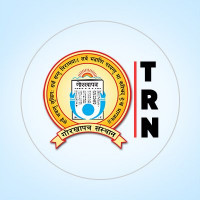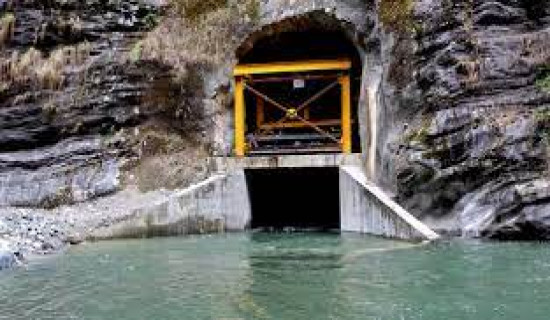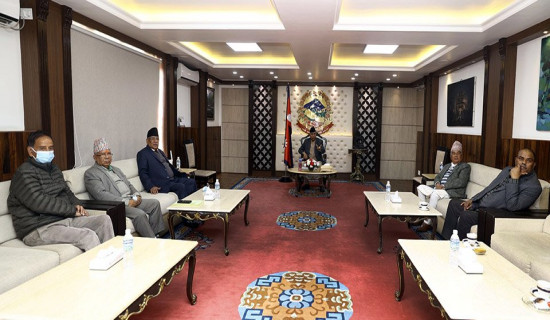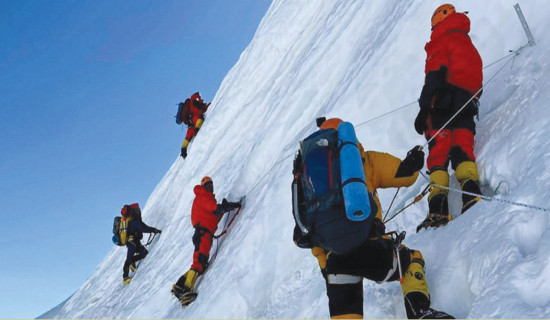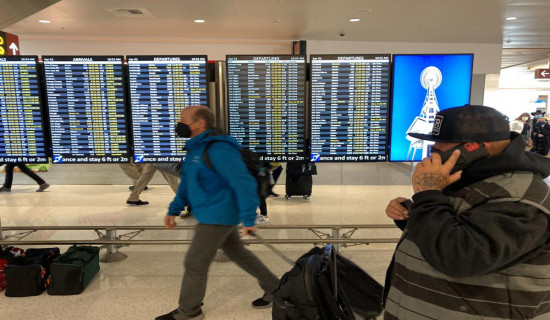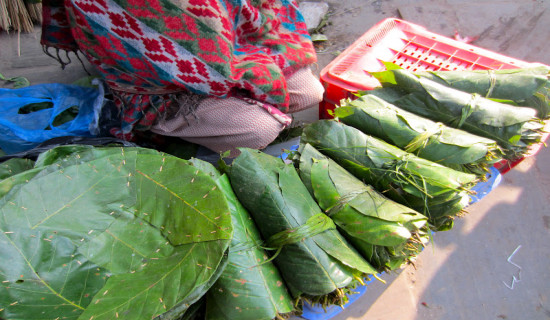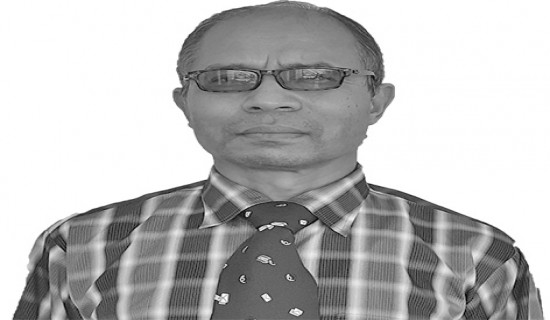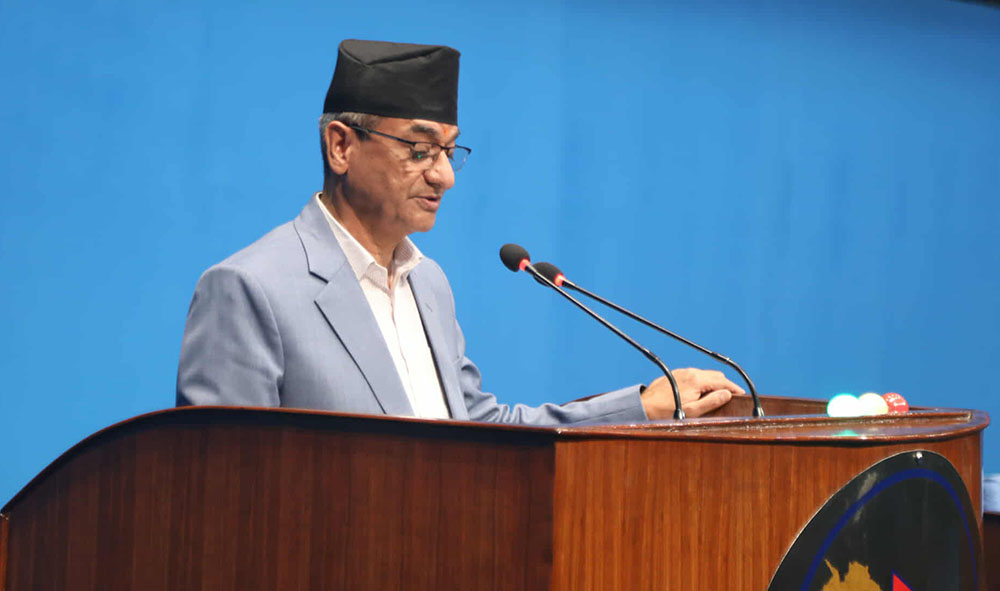- Wednesday, 3 September 2025
Conspiracy to break alliance - PM Deuba
Prime Minister Sher Bahadur Deuba has said that there is a conspiracy to break the alliance.
2.5 million children receive typhoid vaccine in 10 days
About 2.5 million children aged between 15 months to 15 years have received a dose against typhoid within the first 10 days of the nationwide typhoid vaccination campaign.
Melamchi water arrives at Sundarijal
Kathmandu, April 19 : The water fed to the tunnel from Melamchi Drinking Water Project at Helambu Rural Municipality of Sindhupalchowk on April 12 arrived at Sundarijal, Kathmandu at about 10:00 pm Monday. It will take three to four days to fill up storage, according to engineer at consultant company for project, Bibek Khanal. The water could be noticed at washing channel last night, which proved that the Melamchi water arrived at Sundarijal, he added. The tunnel closed since July 15 has been washed to clear the trashes and debris. The water is now drained into the Bagmati River, which has increased water flow. A local Ram Prasad Pudashaini informed that water flow was increased in the Bagmati River at present. On the very day the water induction into the tunnel was stopped last year, Melamchi River flood had damaged the project structures. The reconstruction of the source structure was completed and water inducted last month. After the water level gains height, it would be sent to the processing centre of Sundarijal. Minister for Drinking Water and Sanitation Umakant Chaudhari is scheduled to visit Sundarijal today, according to spokesperson for Melamchi Drinking Water Project, Rajendra Pant.
7th agro census kicks off
The seventh national agriculture census has begun today. Every agricultural activity including details of families involved in agriculture would be incorporated during the census.
Egypt female TikTok star jailed for three years for human trafficking
An Egyptian TikTok star has been sentenced to three years in prison after a court convicted her of human trafficking at retrial. Haneen Hossam, who is in her early 20s, was accused of exploiting girls for money through video-sharing platforms.
Ruling coalition meeting at 2 pm today
The meeting of the five-party ruling coalition scheduled for 11:30 am on Tuesday has been postponed till 2 pm.
Application for Miss Nepal opened
The Hidden Treasure (THT), the official organizer of Miss Nepal for the past 27 years, has announced the opening of an application for Miss Nepal Pageant 2022.
740 mountaineers get climbing permission this season
By A Staff ReporterKathmandu, Apr 19 : A total of 740 climbers from 70 nations have obtained permits to scale Nepal’s mountains this spring. As per the data provided by the Department of Tourism (DoT), 155 females and 585 males from six continents of the globe have received permission to climb Nepali peaks till Sunday.Of them, the largest number is from the United States of America. A total of 117 mountaineers, including 94 men and 23 women, have come from the US to climb mountains.Similarly, the second-highest number, 74, is from the United Kingdom and the third-highest, 55, is from India. Likewise, 17 people from Nepal’s northern neighbor China are going to be making attempts at our peaks too.There are climbers from Russia and Ukraine too. There are 25 climbers from Russia and one from Ukraine. Russia and Ukraine are currently at war with each other and the former has been heavily sanctioned by the western countries.The government has collected more than Rs. 395 million in royalties from the climbers who have been permitted 21 peaks including Mount Everest. The other peaks that have been opened to mountaineers are Amadablam, Annapurna I and IV, Baruntse, Bhemdang Ri, Dhaulagiri, Gangapurna, Himlung, Kanchenjunga, Khangchung, Lhotse, Makalu, Manaslu, Mukot, Norbu Khang, Nuptse. Phu Kang, Pokhar Kang, Saula, Thapa Peak and Urknmang.The spring season is considered the best time to climb Mount Everest, the world’s highest peak. That is why the largest number of climbers – 262 individuals from 32 teams – have applied to attempt an ascent on the peak this time. A total of Rs. 332,114,100 royalty is collected from them.
NC Stands To Benefit From Poll Alliance
Narayan Upadhyay The electoral alliance designed to contest forthcoming local polls has sent ripples to the ruling partners, notably the Nepali Congress (NC). As a result, the five parties have so far failed to reach an understanding on sharing seats in all 753 local units. With the May 13 poll drawing closer, the ruling coalition is still unsure about dividing posts for mayors, deputy mayors, chairmen and deputy chairmen, besides the posts forward chairmen. For the ruling parties, sharing six metropolises and 11 sub-metropolises with their respective mayoral candidates has proved a gargantuan task because of resentment among NC leaders.For now, the NC is eyeing three metropolises - Kathmandu, Lalitpur and Biratnagar - for its mayoral aspirants, while the CPN-Maoist is gunning for Bharatpur Metropolis and the CPN-Unified Socialist claiming its right to compete in Pokhara. The Janata Samajbadi Party hopes to gain a mayoral seat in Birgunj. The allocation of sub-metropolises for their mayoral contestants proved a task strewn with complications. Local needDespite all hindrances, these allies reached an understanding that the party that had won mayoral positions in the metropolises and sub-metropolises will keep them while they will share the seats that were won by UML in the last election. They also settled that the distribution of seats in municipalities and rural municipalities will be conducted based on local needs and emerging situations.Despite the central leaders of the ruling partners reaching a general understanding, several NC leaders, including senior leader Shekhar Koirala and general secretary Gagan Thapa, are at loggerheads with their party establishment, headed by the party president and Prime Minister Sher Bahadur Deuba, over the electoral alliance. They contended the alliance would curtail the party's significant chance of securing a bulk of mayoral and other seats in all local bodies. For these leaders, the electoral alliance is nothing but a step towards undermining democratic culture and party principles. Similarly, Congress leaders at some local bodies, such as Chitwan and many other places have protested against the allocation of mayoral seats to coalition partners, showing their dismay over the alliance.Given the level of dissatisfaction, the elective partnership has developed into a Gordian knot for the NC leadership at present, despite the party president Deuba sticking to his stance that the arrangement of seats must take place. Dubai maintained that Congress would not abandon its current partners who played a key role in catapulting the NC into government leadership following the collapse of the KP Sharma Oli-headed government. The NC establishment expects to extend the electoral alliance with ruling parties up to provincial and federal elections to be held in six months following local polls.However, NC leaders, who are against the poll alliance, have harboured hopes that the party would make huge achievements in the elections because of the ongoing tussle among the communist parties, especially among the UML and Maoist Centre and Unified Socialist. The split in the erstwhile Nepal Communist Party that continued their rivalry for the upcoming local poll will come in handy for the NC of winning a majority of local bodies this time.Perceiving a landslide win for the NC in the aftermath of the communist discord may appear right at the moment. But Congress dissidents must not overlook one key point - political parties must not constantly search for triumphs and gains at the cost of leaving in the lurch the same partners who supported them when they were passing through a precarious period. Such a posture may be immoral and is regarded unsuitable to a party like NC. When it was in the wilderness after a major poll debacle, the Maoist Centre, Unified Socialist, Janata Samajwadi and Rashtriya Janmorcha lifted it out of the woods by throwing their weight to create a government under its leadership.Also true is the fact that the NC at present has had a major adversary - UML and its maverick chair, Oli. Given the current political situation, Oli has demonstrated that he could go to any length to outwit the ruling alliance in the local, provincial and federal elections, though political pundits predicted a heavy loss for the UML in the three-tier elections. Having allied with the ultra-rightist party of Kamal Thapa's RPP-Nepal and pro-Christian party, Nepal Pariwar Dal, Oli has made his intentions clear. In the past, Oli sprang a tremendous surprise by forming a unity with the then bitter foe - the Prachanda-led Maoist Centre. In the meantime, whenever NC leaders raise their voices against the current poll alliance and share seats for local elections, the Maoist Centre chair states he may ally with the UML. By going against understanding over the polls, dissatisfied Congress leaders must not push Maoists and other coalition partners to the wall at this juncture.Threat For the NC, Oli and other communist leaders still pose a threat. Though the three communists may contest local elections as foes, a defeat in this poll may provide them with yet another opportunity to forge unity for the provincial and federal elections. If one combines all the votes cast for communist parties, they possess an edge over the NC in all forms of elections in the nation. Forgetting this may cost heavy for Congress, especially for those who protested the idea of seat-sharing in local polls. Giving continuity to the current company would be beneficial to NC, the largest party of the alliance. In case the coalition wins a handsome majority in the local polls, the oldest democratic party in the nation is likely to emerge as the largest in provincial and parliamentary polls, allowing it to head the next government while other partners participate as key members. (Upadhyay is the managing editor of this daily. nara.upadhyay@gmail.com)
Madrid fight back to stun Sevilla
AFPMadrid, Apr 19 : Karim Benzema completed another incredible Real Madrid comeback on Sunday as they fought from two goals down to defeat Sevilla 3-2 in La Liga.After trailing Chelsea 3-0 on Tuesday only to secure their place in the Champions League semi-finals, Madrid stunned Sevilla to seal the victory that has surely won them La Liga.Defeat would have given fresh hope to the chasing pack, with Sevilla and Barcelona both beginning the day 12 points behind, Barca with two games in hand. Instead, goals in the second half from Rodrygo, Nacho Fernandez and Benzema in the 92nd minute mean Madrid extend their advantage to 15 points with six games left to play.An Ivan Rakitic free-kick and Erik Lamela's smart finish had put Sevilla two up at the Ramon Sanchez Pizjuan."It's difficult to understand why we played like that in the first half and to be honest how we played as well as that in the second," said Carlo Ancelotti. "In the first half we looked tired. In the second, the intensity was spectacular." Benzema now has 44 goals in 46 appearances this season and 15 in his last 10.Last-gasp CarrascoTen-man Atletico Madrid left it late too as Yannick Carrasco scored the winning penalty with the last kick of the game for a 2-1 win over Espanyol.Atletico looked set to drop another two points at the Wanda Metropolitano when Geoffrey Kondogbia was sent off in the second half and then three minutes later Raul de Tomas cancelled out Carrasco's opener, his free-kick squirming through the fingers of Jan Oblak. But De Tomas handballed deep into added time, the referee awarding the spot-kick after a long consultation with VAR, before Carrasco held his nerve. The ball hit the net with the clock approaching 100 minutes."It was an important game for us and when you score with the last kick of the game it feels even more important to achieve our goal this season," Carrasco said.Atletico stay three points clear of Real Betis in fifth and level on points with third-placed Sevilla.
Florida judge voids US mask mandate for planes, other travel
By CURT ANDERSONST. PETERSBURG, Fla. Apr 19 , (AP) : A federal judge in Florida struck down the national mask mandate covering airlines and other public transportation Monday, and the Biden administration said the rule would not be enforced while federal agencies decide how to respond to the judge’s order.The ruling appeared to free operators to make their own decisions about mask requirements, with several airlines announcing they would drop mandates but New York City’s public transit system planning to keep one in place.The Association of Flight Attendants, the nation’s largest union of cabin crews, has recently taken a neutral position on the mask rule because its members are divided about the issue. On Monday, the union’s president appealed for calm on planes and in airports.“The last thing we need for workers on the frontlines or passengers traveling today is confusion and chaos,” union leader Sara Nelson said.Nelson said it takes airlines 24 to 48 hours to put new procedures in place and tell employees about them. She said passengers should check with airlines for updates about travel requirements.The decision by U.S. District Judge Kathryn Kimball Mizelle in Tampa, an appointee of former President Donald Trump, also said the U.S. Centers for Disease Control and Prevention failed to justify its decision and did not follow proper rulemaking procedures that left it fatally flawed.In her 59-page ruling, Mizelle said the only remedy was to vacate the rule entirely across the country because it would be impossible to end it for the limited group of people who objected in the lawsuit.The judge said “a limited remedy would be no remedy at all” and courts have full authority to make a decision such as this — even if the CDC’s goals in fighting the virus are laudable.The Justice Department declined to comment when asked if it would seek an emergency stay to block the judge’s order. The CDC also declined to comment.The White House said the court ruling means that for now the mask order “is not in effect at this time.”“This is obviously a disappointing decision,” White House press secretary Jen Psaki told reporters. “The CDC is recommending wearing a mask on public transit.”The CDC had recently extended the mask mandate, which was set to expire Monday, until May 3 to allow more time to study the BA.2 omicron subvariant of the coronavirus now responsible for the vast majority of cases in the U.S.In New York, Metropolitan Transportation Authority communications director Tim Minton said the system was “continuing to follow CDC guidelines and will review the Florida court order.”The MTA operates New York City buses and subway trains as well as two commuter rail lines. Face coverings have been mandatory on all trains and buses since early in the pandemic.United Airlines said in a statement that, effective immediately, masks would no longer be required on domestic flights or certain international flights.“While this means that our employees are no longer required to wear a mask – and no longer have to enforce a mask requirement for most of the flying public – they will be able to wear masks if they choose to do so, as the CDC continues to strongly recommend wearing a mask on public transit,” United said.Delta Air Lines and Alaska Airlines also made similar announcements.The federal mask requirement for travelers was the target of months of lobbying from the airlines, which sought to kill it. The carriers argued that effective air filters on modern planes make transmission of the virus during a flight highly unlikely. Republicans in Congress also fought to kill the mandate.Critics have seized on the fact that states have rolled back rules requiring masks in restaurants, stores and other indoor settings, and yet COVID-19 cases have fallen sharply since the omicron variant peaked in mid-January.There have been a series of violent incidents on aircraft that have mainly been attributed to disputes over the mask-wearing requirements.The lawsuit was filed in July 2021 by two plaintiffs and the Health Freedom Defense Fund, described in the judge’s order as a nonprofit group that “opposes laws and regulations that force individuals to submit to the administration of medical products, procedures and devices against their will.”Republican Florida Gov. Ron DeSantis, who was not directly involved in the case but has battled against many government coronavirus requirements, praised the ruling in a statement on Twitter.“Great to see a federal judge in Florida follow the law and reject the Biden transportation mask mandate. Both airline employees and passengers deserve to have this misery end,” DeSantis tweeted.
Arghakhanchi women earning livelihood selling duna-tapari
By Our CorrespondentArghakhanchi, Apr 19 : Locals in Thada, in Arghakhanchi, have started earning good income from Duna-tamari (plates made of leaves from the 'Saal' tree) business. Most of the women of Sitganga Municipality are on cloud nine after they started making good money from the business. They have been selling Duna-tamari both individually and in a group after collecting leaves from the forest. Demand for such plates increased after the municipality was declared a plastic-free market zone. Municipality Chief Surya Prasad Adhikari said that it was made a plastic-free zone with the objective of making Damaru Daha, in Thada, a tourist attraction and making the city clean and pollution-free. The municipality has been teaching the women to make the plates in order to make the city a beautiful tourist destination.An area covering a distance of around 400 meters from Thada has been made plastic-free. For the first time, about one year ago, 17 women from this region were trained to make Duna-tamari. The women have been able to earn a good income since then. Chiuri and Saal trees abound in the nearby community forests. The women can collect their leaves easily to make Duna-tamari. The women's group of the Local Sagarmatha Women's Cooperative has been making Duna- tapers to sell in the market. "We are creating self-employment by selling Duna-tapers in the market," said Laxmi Belbase, chairperson of the group. Instead of plastic cups, plates, and bowls, people have now started using Duna-tamari in ceremonies and functions.
Ensure Safety In Water
Drowning in rivers, rivulets, lakes and other water bodies has been a major problem even in Nepal where many such incidents are reported time and again. Swimming lovers, especially adolescents and young adults, are found falling prey to their adventurous steps into water bodies. There has been a rising propensity among school and college-level students to go for swimming as a recreation and sporting activity. Since the densely populated Kathmandu Valley does not have natural swimming facilities, a number of people interested in water sports go to different places. The Trishuli River and the Sunkoshi River are the two key water bodies that many Kathmandu dwellers visit each year to enjoy swimming. People find it quite convenient to go there on weekends and other holidays as these water bodies are located close to Kathmandu. One of the obvious reasons for drowning is that many swimmers hardly have basic floating skills. Besides, they sometimes fail to calculate the depth of the river or lake before entering into water. They also rarely use swimming gear like a life jacket while jumping into rivers or lakes. It is quite worrying that the country reports more than 500 cases related to drowning annually. According to a news report published in this daily on Monday, as many as 16 persons, including seven children, died of drowning nationwide in the past two weeks (April 3-16) alone. A 22-year-old boy from Dolakha was among them. The boy along with his friends had gone to the Sunkoshi River for swimming on April 16. However, six of his friends survived. The boy had dived too deep and gone missing in the river. Because the unfortunate incident had taken place in an isolated area, no rescue team was able to reach there on time. The boy’s body was recovered only the following day. Drowning-related incidents are mostly reported during the hot season when more people opt for swimming for cooking. Currently, temperatures have gone up considerably, prompting people to take different measures to beat the heat. The situation is worsening in the Terai as it is the hottest region of the country. Most people living in the Terai districts go swimming during this season. Even small children are seen swimming in rivers and lakes. An eight-year-old boy in the Saptari district and another five-year-old girl in the Rautahat district met the same fate last week. Drowning is also a worldwide problem. As per the World Health Organisation (WHO), some 236,000 people die of drowning globally each year. The global health body’s data shows that the highest drowning rates are among children aged 1–4 years followed by those aged 5–9 years.Looking at children’s vulnerability to drowning, officials at the National Disaster Risk Reduction and Management Authority under the Ministry of Home Affairs (MoHA) have stressed the need for the respective families to properly monitor the activities of their kids to save them from drowning and other risks. It is also the responsibility of the local government institutions to create massive public awareness in the communities against the possible risks of drowning. They also need to have well-trained rescue people to deal with this problem. What is equally essential is teaching school-age children basic swimming, water safety, and safe rescue skills to help prevent the incidents of drowning.
Remittance For Economic Development
Uttam MaharjanNepal is basically a remittance- and tax-based economy. Although there are abundant internal resources that can be utilised to boost exports, such resources are left fallow and imports are prioritised. When imports are made in large quantities, the government can levy imports duties, which can be used to supplement the national budget. This can be termed an import mentality.Nepal is one of the least developed countries in the world. Although there is some development in the urban areas, the rural areas are still poor. It is estimated that one in every five rural households is poor. As the rural areas lack development infrastructure and there is a paucity of job opportunities, the rural youths tend to migrate to the urban areas or abroad for jobs. So, labour migration has been one of the important components of the economy. Labour migration has intensified, especially for the last two decades. Women also migrate abroad for jobs. But they constitute only about five per cent of the total migrant labour force. Labour destinationsThere are over 100 labour destinations for Nepalis. Among them, Qatar, the United Arab Emirates, Saudi Arabia, Kuwait and Malaysia constitute the top five labour destinations. The migrant workers working abroad send remittance money back home. As per the Nepal Living Standards Survey (NLSS) III (2010/11), 56 per cent of the households receive remittances. And one in every two rural households receives remittances as per the data issued by the Ministry of Finance (MoF) in 2020.For a poor country like ours, the importance of remittances can hardly be overstated. Remittances have played a vital role in alleviating poverty in rural areas. The reduction of poverty in the country can be attributed largely to remittances.In 2010, the rate of poverty was 25.2 per cent, which came down to 16.6 per cent in 2016. Viewed thus, remittances have a positive impact on the uplift of the standard of living of the rural folks.Most of the remittance money is, however, used to cover family and social expenditures. Remittance-receiving households tend to spend much money on food, house construction and social events. They also spend it on loan repayment, education and healthcare. Spending remittances in the productive sector such as agriculture and cottage industries would further reduce poverty in the rural areas.Remittances are also the sources of liquidity in the banking sector which is now facing a liquidity crunch. A low inflow of remittances is cited as one of the factors contributing to the liquidity crisis. In Magh, the inflow of remittances was down by 4.9 per cent, whereas it was down by 1.7 per cent in Falgun. The country had received Rs. 631.19 billion till Falgun of this fiscal year. During the corresponding period of last fiscal year, the inflow of remittances was up by 8.7 per cent. The contribution of remittances to the country’s GDP is around 25 per cent.It may be noted that banks give higher interest on remittance accounts in order to encourage migrant workers to send money back home through the banking channels. This does not, however, mean that foreign employment is bad per se. Labour migration is a global phenomenon. As per the World Bank report of 2020, there are almost 272 million international migrants throughout the world. Of them, nearly two-thirds are labour migrants. In recent times, the country has suffered a malaise in the economic sector.This is due mainly to disproportionate imports vis-à-vis exports. The foreign reserves are also dwindling. In Asadh, the country had foreign reserves of Rs. 1,399.03 billion. The foreign reserves came down by 16.3 per cent to Rs. 1,171 billion in Falgun. It may be germane to note that Nepal Oil Corporation’s inability to pay fuel bills to Indian Oil Corporation has surfaced. At the same time, the news of Sri Lanka being in economic straits is swirling around the world. And the detractors of the government, including CPN-UML chairman KP Sharma Oli, have raised false alarms that the economy of the country is going the Sri Lankan way. Banking channels The government is mulling over increasing the inflow of remittances. Not all remittances come through the banking channels. There are many Nepali migrant workers who prefer the hundi and other informal channels over the banking channels to send money back home. The Nepali migrant workers should be encouraged to use the banking channels by providing them with incentives such as increased interest. Exporting labour abroad is a lucrative business as shown by the contribution of remittances to the national economy. However, this has created problems in the rural areas. There are mostly the elderly and children in the rural areas, with the youths having migrated to the urban areas or abroad. The rural farms are left barren for lack of labour. The government has not paid heed to infrastructure development in rural areas. The rural areas have a multitude of problems, be it in education, healthcare or transportation. Moreover, there is lack of job opportunities. The government should, therefore, take concrete measures to improve the rural conditions without delay. (Maharjan has been regularly writing on contemporary issues for this daily since 2000. uttam.maharjan1964@gmail.com)
Overcoming Phobias
Irina ShlionskayaMany people suffer from some kind of phobia. Some are afraid of open spaces, others are closed. Someone is afraid of spiders, dogs or rats. Someone - fire or water. But there are fears that are difficult to explain. For example, how can you be afraid of stairs? After all, we have to deal with them literally at every step. Nevertheless, such a phobia exists.There are people who are afraid of heights. They will never dare to climb to the top floor of a high-rise building. But not all stairs are so high. So experts distinguish the fear of stairs into a separate variety - climacophobia. British Richard Smith is now over 50. At the age of three, he fell down the stairs in the house where he lived with his parents. Since then, the fear of stairs began to haunt him.When the boy was eight years old, he went on an excursion to one of the castles with his school class. And, although little Dick really wanted to go there, he could not enter there, because he had to climb the stairs.He began skipping classes if he needed to climb stairs to class. In physical education classes, he could not climb the Swedish wall, and during swimming, he refused to enter the pool, because there was a descent down the stairs. Peers laughed at Dick, but he could not do anything about his phobia. When he was 15, Dick began dating a pretty girl of the same age. One day she suggested meeting at the water tower. But he could not go there, because the stairs also led to the tower. Of course, he could not confess his fear to the girl. She got offended.The next time he saw his girlfriend was sitting on the steps of the bus. Dick wanted to go up to her and explain, but the girl went upstairs and looked contemptuously at the failed gentleman. Richard had to constantly struggle with his phobia and hide it. He even climbed the bell tower when it was time to propose to his future wife. But during their honeymoon, he and Katherine had to walk a lot around the city, and the newlywed realized that something was wrong with her husband.It was only at a fairly mature age that Smith finally went to see a psychotherapist. The fact is that at that time he was writing a book about the first British balloonist James Sandler, and his fears prevented him from working on the book. The psychiatrist diagnosed him with two phobias at once: acrophobia - fear of heights and climacophobia - fear of stairs. Of course, all this was due to a fall in early childhood. As a therapy, the specialist offered the man a shock method - to climb the high tower in Oxford and bend over the railing. Oddly enough, this helped Richard. The fear of stairs is gone. Soon Smith climbed the bell tower for the second time in his life and was able to enjoy a beautiful view. And after some time, he even managed to realize his old dream - to fly in a hot air balloon. In most cases, phobias are still curable. At least psychotherapy can significantly alleviate the condition of those suffering from various fears.

